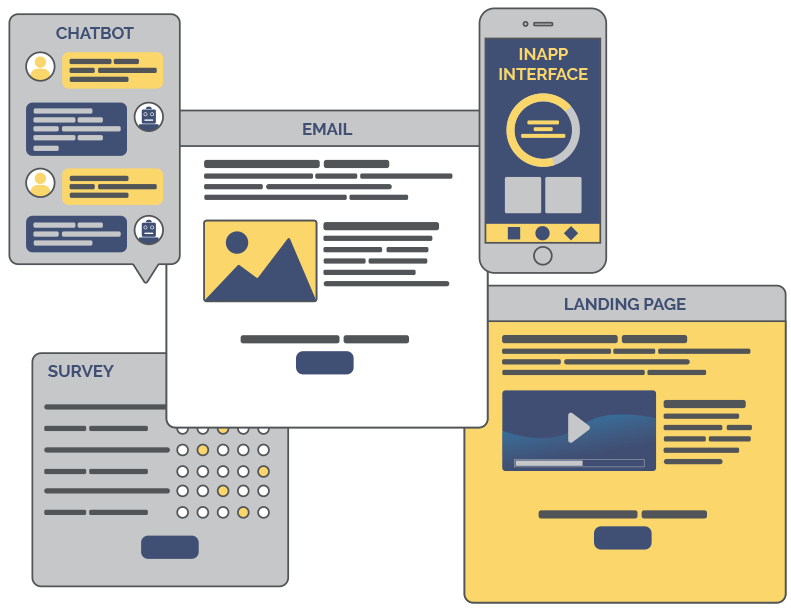It takes more time and effort than traditional advertising, so is having a content plan even worth it?
Content marketing is a well-known term by now.
Most large corporations use it to create brand awareness and to generate inbound leads. With the market saturated with competitors, it is important to make a company stand out from the crowd. This constant flow of content is often used to shift website traffic from ‘paid’ to ‘organic’ and it is used to create better understanding and interest in a topic or product.
Not only can this constant flow of content create better awareness, but it is often much more cost-efficient than any other high-volume tactic for generating website traffic, such as display ads on websites or social media. The key to this success is in providing informational content that fulfills the needs of the audience, rather than creating blatantly promotional content for your products.
However, for a small, fast-growing company, it can be daunting to embark on implementing a content strategy. Content creation can be time-consuming, the insights and deep knowledge required usually have to come from top management which is more work for them, and the distribution and effect of the strategy is never guaranteed.
To many, simply driving traffic to a website through search engine marketing and social media ads seems to be the fastest and easiest way to gain traction in the market. It can be handled by junior employees, it has an instant effect and it doesn’t require much involvement from key people in the organisation.
“A constant flow is the way to go!”
Is traffic to the website, generated from search engine marketing and social media ads really a good indication of market traction? How big is the impact on sales? Does it build a community? Does it convince those early adopters about the value your product can create? Does it inspire people and does it create referrals?
The answer to all these questions is no…so a constant flow of content is the way to go!
Content strategy
The market is not a singular voice that makes rational decisions. Trust and understanding don’t just appear out of thin air. And no, the market is not just dying for someone to disrupt it and change everything!
Ciarán Ó Conluain, from content company BeCreative Media Group (www.becreative.ie) says, “Customers want to know what your company is all about and it is your job to tell them in new and innovative ways. Customers don’t just want a few lines on how you got started, they want to know how your service works, the value you can create for them and how you are different to competitors in the market. This is where a constant flow of content is important as it can help make you stand out in the ongoing feed that is the internet user experience. Marketing on the internet is a matter of who has the largest volume in their content flow, and who has the most engaging content.”
It is immensely important for early stage companies to produce a steady flow of content about all of this information along with who they are, how their business model works, what their pricing is based on, who the service is for and where their inspiration came from.
How some brands fail miserably with content
There are some brands which fail spectacularly at creating content. One of the reasons for this is they have no content strategy. They don’t plan their content, or research the best avenues to release the content to their particular market. The content is not planned enough and when content is created haphazardly, it shows. But worst of all, the content is boring or not planned as a constant flow. No one wants boring content every now and then, so make sure to pay attention and keep readers interested.
Why have a constant flow of content?
- It can create more brand awareness and leads
- It’s far more cost-efficient than traditional advertising, but can take more time to do it well
- Search engine marketing can generate traffic but content is more likely to generate actual subscribers
- Volume is key, as is the right story and a continuous flow
- If a company won’t do it for themselves, then who the hell else is going to do it? A company needs to take charge and get themselves out there.
Content is king
With 78% of consumers preferring articles to ads, can you really afford not to have a content plan?
So, what type of content should you be creating? The usual suspects are always copy, video, images and graphics.
Copy / text - This is fairly simple to produce (at least compared to the others!). It can be produced, edited, published and distributed with very few resources and in a relatively short time period. Text is great for Search Engine Optimisation (SEO) as it drives ‘free’ traffic to your website through key search terms. It is also a great way of producing deep insights and knowledge for customers looking for a solution to their problem. With text you can go into detail about the problem, why it is a problem and the solution you offer.
Tip: For maximum impact, you can use tools like BuzzSumo (www.buzzsumo.com) to find trending and popular topics to write about. Or, if you want to set yourself apart from bigger companies, try writing about niche topics that are not well-covered.
Video - These days you need to have video. It is great for creating awareness and for appealing to more emotional reactions from customers, such as joy, compassion, surprise and trust. Video is still the ultimate champion at getting attention in people’s social media feeds which drives a lot more visitors to your site. It is far better at communicating messages that are slightly more complex, or that need to set a certain mood. With video you can use images, text, music and narration to form a complete picture of your message.
But always remember that video has more power than any other content. Beware confusing video content with video advertising. An advert is a hard sell video and a traditional sales pitch. Video content, on the other hand, is usually created to educate, to inform, to inspire, and even to make you cry at your desk at work! It is far more subtle and oftentimes, more personal. For example, the US make-up store Sephora creates video content for YouTube, with their top make-up artists giving practical tips on how to apply make-up and finding the right foundation/eyeshadow/lipstick. Whereas their adverts are more obvious sales pitches, showing the types of make-up and the prices. If a customer is expecting the former and instead gets the latter, they will most likely be disappointed. Know your audience and what their expectations are.
Tip: Videos can be anything from ‘How-to’ tutorials to customer testimonials. For examples of some great creative content creation videos, see www.mediaplanet.com/us/blog/insights/7-stellar-examples-of-creative-content-marketing-videos
Images - Photos are great for showcasing your work, your people or your events. ‘Show, don’t tell’ is a great expression and the old cliché, ‘a picture is worth a thousand words’, is actually true! Photos of real people and pictures of your products can put a visual value to your company. Faces and visuals drive trust, familiarity and interest.
Tip: Make sure you always have a photographer around for your events so you can show online just how engaged your community is. Make sure you always use meta descriptions when publishing too, as this is crucial for on-page SEO. For some good examples, visit www.contentmarketinginstitute.com/2016/09/smart-marketing-examples-visual/
Graphics - Using graphics in your content is great for visualising something that is otherwise intangible, such as a concept or a process which is hard to grasp. A concept can be difficult to describe in words and you can easily create a much quicker understanding of the value your company brings to the table through infographics. They are also easy and attractive to share on social media and they can grab attention, which is exactly what you want.
Tip: Free tools like Canva (www.canva.com) and PicMonkey (www.picmonkey.com) allow you to create quick graphics for social media, while tools like Venngage (www.venngage.com) and Ceros (www.ceros.com) allow you to make more interactive infographics.
Content creation
So now you know what you should be publishing. But, how should you go about creating all this fabulous content?
Plan ahead
When starting a content strategy, publishing a text piece tomorrow and then a video in three weeks isn’t enough to capture the attention of your audience. Your readers need to know when they should expect content from you and publishing on time creates trust between you and your readers.
Use a content calendar to plan what and when you are going to create in advance. Good, high-quality content takes a lot of time to create, so you need to plan ahead in order to have it ready for your schedule. Figure out how many days a week you will post new content, what type of content it will be and what time is suitable. Make sure to post content at least once a week to make sure your strategy is regular.
Once you have a content calendar, you will be able to see far ahead so you will never forget to post.
Good, high-quality content takes a lot of time to create, so you need to plan ahead in order to have it ready for your schedule.
Serve Drips
Serving the content as a complete piece can work fine. But if you instead serve the content one small piece at a time in the form of email drips, it is much more effective. For example, a 1,500 word article might be very well-written, but most people won’t read it on the bus and most definitely not in one go. However, a shorter piece of the overall article sent out to readers, will be much more engaging and more likely to be read. Customers are more likely to read bite-sized chunks rather than the whole cake. According to a Hubspot study, 73% of consumers prefer to learn about a product or brand in trickles or drips, over getting all the information in one big package all at the same time.
For the reader, there are many benefits. They can read on mobile so they can stay up-to-date even while travelling. These days, everyone is short on time and might not plan to read a long text post, but if you send reminders for more content after they have read something on your blog, the customer can stay engaged. For the company, keeping this constant flow of content going keeps the attention of the customer for much longer. It keeps the reader in suspense and has them expect to hear from you rather than having to remember to go back to your blog. You can even use reading data from their engagement to score leads.
Tip: The primary goal of a drip campaign is to attract the right subscribers. Remember to add a clear call to action with all of your content to get them to continue interacting with the rest of your content and to become subscribers.
Delegate
Research, writing, editing, proofreading, creating graphics and video all take time. This is time you might not have as you are doing everything else a fast-growing company requires. How you create and execute your content strategy depends on the size of your team.
If you are dealing with the content yourself, you may not have all the skills required. For instance, you may be excellent at creating copy, but you may not have advanced video editing skills. You may be a great photographer, but good-looking graphics may be out of reach. It is critical that your content looks and reads well, so it’s not possible to simply cobble anything together. It may be necessary to outsource your content creation to a specialist content company, or someone within your company’s marketing team who have particular skills.
Experts, such as those at www.becreative.ie, with knowledge on content creation can boost your strategy, take the pressure off top management and allow you to focus on other matters.
Your goal is to engage customers and increase engagement and traffic.
Keep it to ‘good enough’
‘Done is better than perfect’. Nothing will ever be perfect, so getting to ‘good enough’ is often a better ambition. If you are constantly striving for perfection, you will never be able to post any content. As long as you get the big things right, a few small things wrong won’t matter.
No content plan is ever going to be pitch-perfect from day one. Your goal is to engage customers and increase engagement and traffic. Focus on shareability and engagement and your strategy will evolve over the course of the process.
Serving a constant flow of engaging content is vital for:
- Keeping customers/potential customers engaged
- It allows customers to get to know you as a company and begin to trust you
- Customers are more likely to purchase from a company that they know and trust, so you should make it your objective to ensure the customer places their confidence in you
- If you do this with multiple streams of content, such as copy, imagery, graphics, video and constantly planning ahead and keeping in touch with your customers, your strategy can be effective
- Serving drips of content at a time is much more engaging than a long article/video. Keep them coming back for more
- It is more important to have content which is good enough, rather than absolutely perfect
- Plan your content strategy ahead so you know exactly what and when you will post
- You might not be able to do everything yourself, so try reaching out to a content creation company so they can help you with your needs






